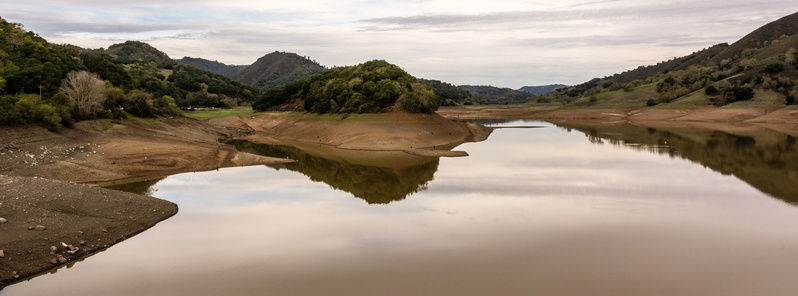Twenty-six water districts in California to begin rationing water

California is slowly fading into desert land. The fight to save the state's water resources has begun at the state level. Governor Jerry Brown recently imposed a 25 percent mandatory restriction on urban water use. This takes effect in July 2015.
This is only the beginning of large scale rationing efforts across the state. Before Brown signed the mandatory water restriction, 26 California water districts were planning to ration water imported into the state. This drastic measure has only happened twice before. A vote is expected soon as the Metropolitan Water District of Southern California weighs their conservation options throughout the state.
Nestle exports California water for profit as locals are forced to ration
As 26 water districts begin to ration imported water, the Nestle Corporation is busy extracting spring water 85 miles east of Los Angeles, California. From there the precious water is bottled and exported for sale around the world. In fact, Nestle owns Arrowhead Mountain Spring Water, a 383,000 square foot bottling plant located on the Morongo Band of Mission Indian reservation. This plant also packages purified water for their Nestle Pure Life brand.
By leveraging an Indian reservation, Nestle is able to skirt any state laws concerning water conservation. As locals experience water shortages and as entire water districts ration supplies, the Nestle Corporation is coming under heavy scrutiny as they profit worldwide from California springs. The reservation they leverage is located in a Mojave Desert oasis at the base of the San Bernardino Mountains. After Nestle profits from the water first, there's hardly enough water left to seep downhill to aquifers. Towns are forced to struggle for water as Nestle controls the source.
Local water districts may soon have to pay nearly $3,000 extra per acre foot for emergency water
According to new water rationing rules to be voted on by the Metropolitan Water District of Southern California, local agencies will have no choice but to pay an extra $2,960 an acre-foot when they request emergency water supplies. There isn't a wholesale deal for these local agencies either. Large water purchases that exceed the new allocation standards may cost up to four times more than the regular price. To put this in perspective, an acre foot of water can supply just two households for one year.
The size of the cutback has yet to be decided. Some have suggested cutbacks between 10-20 percent. This means water districts would have to pay extra for the 200,000-400,000 acre feet of water that they could have normally requested under wet conditions. Of course these price increases will be passed on to local residents. Previous rationing efforts in 2009 and 2010 prevented local water districts from over buying high priced water imported into the state. The effort in 2015 may not have the same result because the drought is deepening to new levels.
"The question is how much more can people squeeze out in conservation than they're already doing," said Dennis Cushman, assistant general manager of the San Diego County Water Authority.
At the end of 2012, MWD said there were 2.7 million acre feet of water in storage. By the end of 2014, however, dwindling supplies slashed their water storage by over half, leaving just 1.2 million acre feet in storage.
"It's a big number," Cushman said, referencing the 1.1 million acre-feet that Metropolitan used in 2014. The amount was used to provide water to 2.2 million households for a year.
Working together to solve problems that threaten the existence of mankind
As water is rationed, people are looking at the big picture. Is it ethical for corporations like Nestle to drain the state's springs located on Indian reservations while the locals suffer higher prices and dwindling natural resources?
Another issue is the amount of water that's used in commercial agriculture. How many gallons of water does it take grow the food that's put on your dinner plate every day? Many are turning to self sufficient food growing methods that use around 1/20th of the water that's typically used in commercial agriculture. The Food Rising mini farm grow boxes accomplish just that, growing ultra clean food in a set amount of water in a non-circulating model of hydroponics.
As water becomes a sacred resource in certain parts of the world, humanity must embrace its duty to work together, instead of competing against, to solve problems that threaten the very existence of mankind.
Sources:
http://www.latimes.com
http://rt.com/usa/172764-nestle-california-bottling-plant/
Written by L.J. Devon (NaturalNews)
Featured image: Effect of the drought on Uvas Reservoir by Don DeBold Santa Clara, California (CC Flickr)

Vacaville has the highest base rate pay than any surrounding areas. What are the water districts doing to cut back~we know that deep pockets reside in every county. The new reader meters may be part of the rate hike here and no one had a choice about those being placed. But most of all, everyone across the US needs to avoid buying bottled water, invest in a good water filter and get rid of Nestle who are the culprits draining our water for their own profit here in Calfifornia.
The US govt Water Resources Council coord 9 federal agencies to do a nat’l assessment of water and related land resources. It had economic, social and environmental data. I worked on it. During Pres Jimmy Carter’s administration. This problem, and the Native American lands, was obvious a LONG time ago. How about giving the govt employees and Pres Carter (an engineer) some credit. Pay attention to the scientists !!